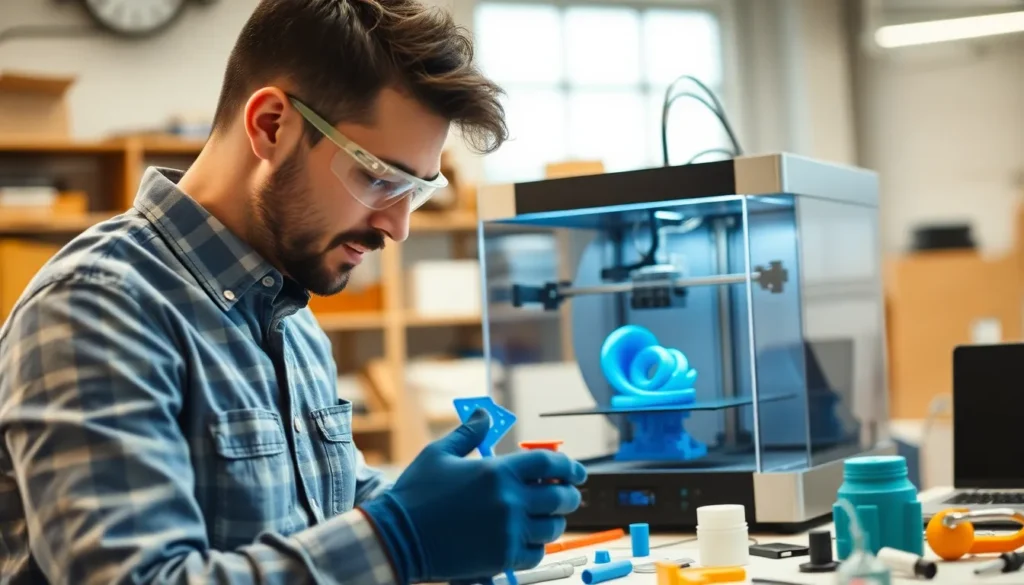Table of Contents
ToggleIn a world where creativity meets technology, 3D printing design optimization is the secret sauce that turns good ideas into great products. Imagine being able to whip up intricate designs faster than you can say “layer by layer.” This isn’t just a dream; it’s the reality for designers who embrace optimization strategies.
Overview of 3D Printing Design Optimization
3D printing design optimization enhances the creation process by ensuring efficient use of materials and time. Designers focus on minimizing waste while achieving the desired performance in the final product. Techniques such as topology optimization lead to lightweight structures without compromising strength.
Iterative testing forms a core strategy in optimization, allowing designers to refine models based on real-world performance data. Simulation software plays a significant role in this phase, providing insights into factors like stress distribution and thermal behavior. By utilizing this software, designers can identify potential failures before physical production.
Anticipating the printing process improves outcomes significantly. Design elements, including wall thickness, support structures, and infill patterns, directly impact printability and durability. Correctly optimizing these elements leads to reduced production costs and enhanced longevity of products.
Material selection also influences optimization. Each material presents unique properties affecting strength, flexibility, and weight. Understanding these characteristics enables designers to tailor their approach, achieving optimal performance for specific applications.
Collaboration among designers, engineers, and manufacturers increases the potential for innovative solutions. Engaging stakeholders throughout the design phase promotes feedback and fosters a culture of continuous improvement. Teams that prioritize communication often realize more successful projects.
Overall, 3D printing design optimization embodies a blend of creativity and analytical thinking. Utilizing advanced tools and collaborative strategies equips designers to transform concepts into functional, high-quality products.
Importance of Design Optimization in 3D Printing
Design optimization plays a crucial role in 3D printing, influencing the overall quality and functionality of printed parts. It drives enhancements in performance while ensuring efficient use of resources.
Enhancing Performance and Functionality
Optimized designs lead to improved performance characteristics, enabling products to meet specific application requirements. Designers employ methods such as topology optimization to achieve lightweight structures that maintain strength and durability. Effective design strategies account for factors like stress distribution, ensuring parts withstand operational demands. Simulation software allows for iterative testing, providing real-world data to refine models further. Each modification leads to better functionality, ensuring that the final product aligns with user expectations.
Reducing Material Waste and Costs
Minimizing material waste directly correlates with cost savings in 3D printing projects. Efficient designs use less raw material without sacrificing quality. By analyzing infill patterns and wall thickness, designers can optimize usage while maintaining structural integrity. Advanced techniques, such as generative design, propose multiple solutions, allowing for the identification of the most sustainable option. Overall, strategic design choices contribute to lower production costs and a reduced environmental impact, aligning with current industry standards.
Techniques for Design Optimization
Design optimization techniques play a crucial role in enhancing the efficiency and quality of 3D printing. These strategies enable designers to create innovative products with minimal waste while ensuring robust performance.
Generative Design Approaches
Generative design leverages algorithms to explore numerous design possibilities based on specified constraints. These constraints can include material types, manufacturing methods, and weight limits. Designers input parameters, resulting in multiple potential solutions that meet user-defined objectives. This technology allows seamless exploration of alternative forms, optimizing for both strength and weight. Autodesk Fusion 360 and Siemens NX are popular tools that support this approach. They promote creativity in 3D printing by allowing designers to focus on functionality rather than conventional design processes.
Topology Optimization Methods
Topology optimization focuses on optimizing material distribution within a given design space. This method identifies the most efficient shape and structure to maintain the required performance while minimizing material use. Engineers can use software like ANSYS and Altair to simulate various load conditions, analyzing stress distribution and identifying weak points. Topology optimization results in lightweight structures that retain strength, making them ideal for applications like aerospace and automotive industries. These methods contribute significantly to enhancing the performance characteristics of 3D printed components, aligning with sustainability goals.
Tools and Software for Design Optimization
Design optimization in 3D printing heavily relies on effective tools and software, which play a crucial role in achieving ideal results.
Popular Design Software Options
Autodesk Fusion 360 ranks among the leading design software tools, providing extensive features for 3D modeling and simulation. SolidWorks also stands out with its intuitive interface and robust design capabilities. Siemens NX boasts advanced functionalities, catering especially to complex engineering projects. ANSYS offers powerful simulation features that enhance product development. Altair enhances design processes through its advanced optimization techniques, particularly in materials distribution. Using these tools, designers can achieve efficient and effective designs tailored to specific project requirements.
Integrating Simulation Tools
Simulation tools significantly impact the design optimization process, allowing designers to analyze performance before production. Advanced software like ANSYS enables real-time testing and diagnostics, ensuring that designs perform under realistic conditions. Designers leverage these simulations to refine models iteratively, improving durability and functionality. Integrating simulation early in the design process helps identify potential failure points, thus reducing material waste and production costs. Tools designed for simulation support both engineers and designers in validating their designs efficiently, enhancing overall project success rates.
Challenges and Considerations
Design optimization in 3D printing comes with challenges and critical factors that impact the success of projects. Understanding these obstacles helps designers navigate the complexities involved.
Technical Limitations
Technical limitations in 3D printing technologies can restrict design possibilities. Some printers support only specific file formats, which may complicate the design integration process. Furthermore, resolution constraints can affect detail quality; intricate designs may require a higher-resolution printer. Each technology, from Fused Deposition Modeling to Stereolithography, presents unique operational limits that designers must consider when creating optimized models. Effective communication between designers and machine operators often mitigates potential issues. Awareness of these limitations enables designers to create feasible, functional models that align with existing capabilities.
Material Selection Issues
Material selection issues significantly influence design optimization outcomes. Different materials present unique properties, impacting strength, flexibility, and overall performance. Some materials require specific printing conditions, which can complicate the design process. For instance, ABS offers strength but may warp during printing, while PLA is easier to work with but lacks durability. Restrictions arise when certain materials aren’t compatible with specific printers or processes, limiting options for designers. Identifying the right material ensures the optimal balance between functionality and manufacturability. Consistent exploration of the latest material technologies can open new avenues for design innovation.
Conclusion
Design optimization in 3D printing is a transformative process that elevates creativity and functionality. By leveraging advanced techniques and tools, designers can create products that not only meet performance requirements but also minimize material waste. The collaboration between designers and engineers fosters innovative solutions that enhance overall project success.
As the industry evolves, staying informed about the latest optimization strategies and technologies will be crucial. This knowledge empowers designers to navigate challenges effectively and produce high-quality components that align with sustainability goals. Embracing these practices will undoubtedly lead to more efficient and impactful 3D printing outcomes.




